
Female antenna

Female antenna

Male antenna

Antennal segments I-III

Head & thorax

Meso & metanota
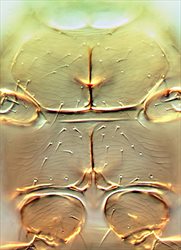
Meso & meta spinula
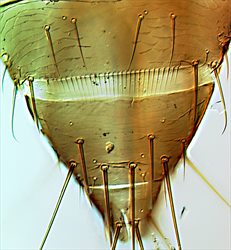
Tergites VIII-X
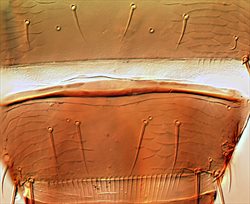
Tergites VII-VIII
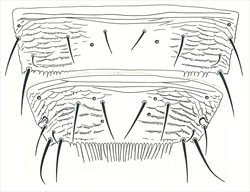
Tergites VII-VIII

Fore wing
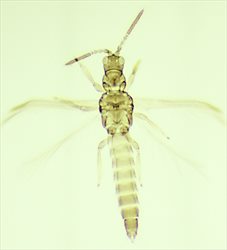
Male
Both sexes fully winged. Body, legs and antennae light brown, tarsi yellow, tibiae yellowish distally; fore wings shaded. Antennae 8-segmented; segment I with paired dorso-apical setae; segments III–IV each with narrowed apex, sense cone forked; VI narrowed at base, VIII longer than VII. Head slightly wider than long; eyes with a few weakly pigmented facets; 3 pairs of ocellar setae, pair III long, arising within ocellar triangle. Pronotum with 2 pairs of long posteroangular setae, two pairs of posteromarginal setae, 24–30 discal setae. Mesonotum without campaniform sensilla anteromedially; median pair of setae near posterior margin. Metanotum irregularly reticulate medially; median setal pair near anterior margin, no campaniform sensilla. Meso- and metathoracic spinula both well-developed. Fore wing with 2 setae on distal half, near apex, second vein with about 15 setae. Abdominal tergites without ctenidia or craspeda; II–VII with no sculpture lines medially, no microtrichia on lateral sculpture lines; tergites VI–VIII with median setal pair more than 0.5 as long as median length of tergite, VIII with complete comb of long, fine microtrichia; IX with 2 pairs of campaniform sensilla, X with short median split. Sternites without discal setae, setae S1 on VII arising in front of margin.
Male similar to female but smaller; Antennae 8-segmented, segment VI longer than combined length of I–V, with numerous long setae but without microtrichia; sternites with discal setae, but without pore plates.
The genus Mycterothrips, with 27 species worldwide, is primarily but not exclusively Holarctic (Masumoto & Okajima, 2006). Five species are known from Europe, with two more in the wider Mediterranean area (zur Strassen, 2003). M. consociatus is one of the species in this genus in which the antennae are sexually dimorphic, in contrast to the other two species recorded in Britain, latus and salicis.
Feeding and breeding on leaves, but probably pupating at ground level. In Britain found particularly on Betula [Betulaceae], but in Europe it has also been recorded from Alnus and Corylus [Betulaceae], as well as Salix species [Salicaceae].
In Britain taken rarely, mostly in southeast England but also Norfolk and Yorkshire (Mound et al., 1976; Collins, 2011). This species appears to have a Euro-Siberian distribution, extending to China and Japan (Mirab-balou et al., 2011).
THRIPIDAE - THRIPINAE
Mycterothrips consociatus (Targioni-Tozzetti)
Thrips (Euthrips) consociatus Targioni-Tozzetti, 1887: 425
Physopus ulmifoliorum var. obscura Uzel, 1895: 123
Physopus ulmifoliorum var. gracilicornis Coesfeld, 1898: 472
Physothrips ulmifoliorum var. schillei Priesner, 1914: 192
Taeniothrips ulmifoliorum f. trisetosa Priesner, 1922: 69
Taeniothrips ulmifoliorum f. pallens Priesner, 1922: 69
Rhopalandrothrips ulmifoliorum f. curticornis Priesner, 1926: 332
Collins DW (2011) The Thysanoptera of Thorne and Hatfield Moors. Thorne and Hatfield Moors Papers 8: 79–85.
Masumoto M & Okajima S (2006) A revision of and key to the world species of Mycterothrips Trybom (Thysanoptera, Thripidae) Zootaxa 1261: 1–90.
Mirab-balou M, Tong X, Feng J & Chen X (2011) Thrips (Thysanoptera) of China. Check List 7: 720–744.
Mound LA, Morison GD, Pitkin BR & Palmer JM (1976) Thysanoptera. Handbooks for the Identification of British Insects 1 (11): 1–79.
zur Strassen R (2003) Die terebranten Thysanopteren Europas und des Mittelmeer-Gebietes. Die Tierwelt Deutschlands 74: 1–271.